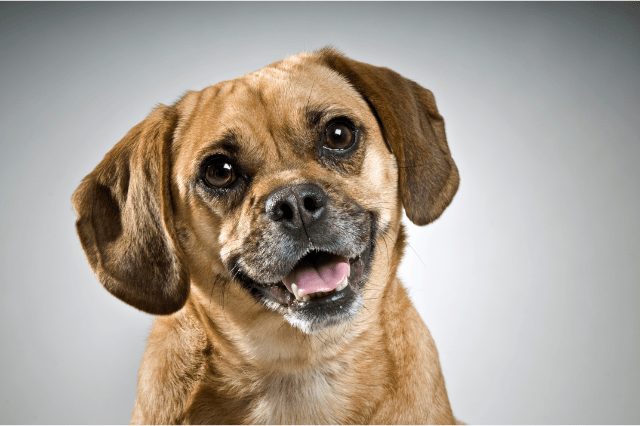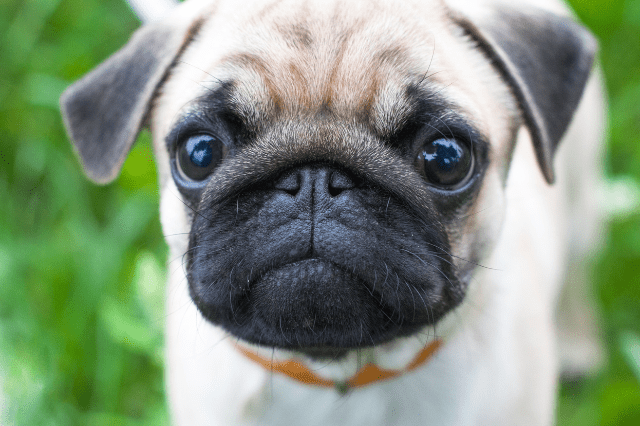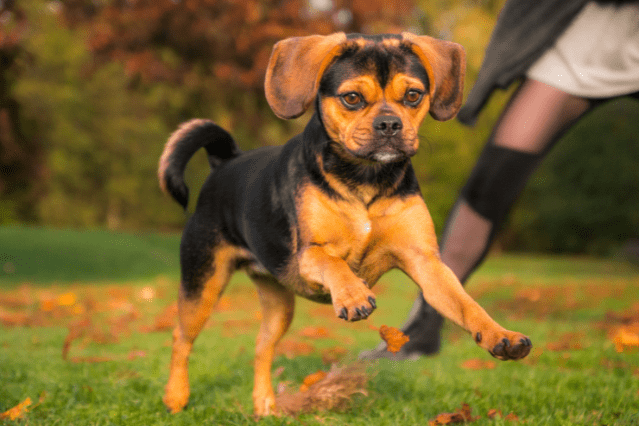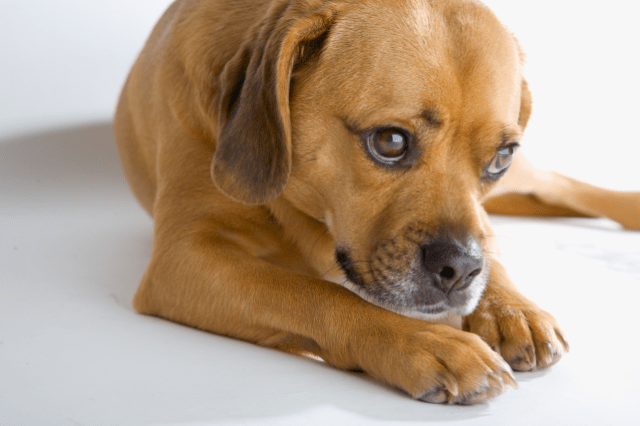Puggle – Everything You Need to Know About This Adorable Mixed Breed

Puggles are the super cute result of mixing a Pug with a Beagle. These happy little dogs are becoming ever more popular. You just have to look at that little face to see why. This mixed-breed dog is enthusiastic, loving, energetic, and very sociable. Puggles love to spend time with their families and are the perfect combination of both parent breeds.
Puggle puppies tend to inherit the cute rolls we all associate with a pug and a longer nose common in Beagles. They also get the Beagle’s floppy ears, making them look a little like a Mini Mastiff.
Are you thinking about adopting a Puggle puppy into your family? Here’s exactly what you need to know about the wonderful Puggle dog.
History of The Puggle
Puggles usually have a Pug father and a Beagle mother – but some litters have been intentionally bred from two Puggle parents. As is the case with many other mixed breeds, it’s thought that Puggles were first bred in the 1990s during the boom of designer dogs.
Of course, these dogs may have occurred naturally years before that. Just like the Retro Pug or Chug, breeders wanted to mix Pugs with other dogs that have a longer snout because Pugs often suffer from respiratory problems associated with brachycephalic breeds.
They also wanted fun-loving, good-nature doggos that would be great family pets!

Puggle Appearance
Because a Puggle isn’t a purebred dog, you can never be 100% sure of its appearance. Some look much more like their Pug parent and others more like Beagles. That’s what makes these dogs so unique!
Your pooch may have a shorter, Pug-like nose however most Puggles tend to have a medium-length to short snout. They may also inherit the underbite of a Pug and their big, endearing eyes (which might bulge slightly too).
These pups can be fawn, black, lemon, tan, or a particolored combination of any of these pictures. It’s also possible for these dogs to have a black mask. There are lots of different Pug colors and your Puggle will likely be one of the more common ones of those!
Puggles are usually bigger than Pugs and have a more Beagle-like build with long legs. They also have super cute triangle-shaped ears that flop over! Puggles tend to have fewer skin folds than a Pug, but will likely have some extra skin around their faces and neck (which is adorable)! Most look generally more like a Beagle, but there are some dogs that look a lot like Pugs.
What Type of Coat Does A Puggle Have?
These wonderful dogs have a short double coat that’s smooth. The undercoat is dense and soft and the outer coat is slightly longer and made up of protective hairs. Like both the Beagle and the Pug, these doggos will probably shed and you’ll need to brush them at least once a week to keep most of the excess fur under control.

Puggle Temperament
Puggles are active dogs that tend to get on well with everyone in the family. They can be playful, cuddly, eager to please, and happy to make canine and human friends.
Because these pups are a mixed breed, again, you can’t be totally sure about their temperament. In all likelihood, however, you’ll get a more active dog than a Pug that’s a little more chilled out than a Beagle.
How Important Is Socialization?
Very! As with all dogs, Puggles need to be socialized from a young age if they’re to become happy and well-rounded dogs. Being slowly introduced to new sights, sounds, smells, and dogs can help your pup grow up to be confident and happy in new situations.
Is It Easy To Train a Puggle?
These little dogs are smart and training shouldn’t be too much of an issue. They’ll be happy to learn new things in return for praise from you or a tasty treat such as watermelon or broccoli.
Puggles can, however, be a bit stubborn. As with many other dogs, the best way to deal with this is with positive reinforcement. Praise your pooch when they do engage in training time and don’t give them any attention when they don’t.
Are Puggles Good With Other Pets?
Puggles can get along with other dogs well. In fact, these sociable pups will be happy to have a canine companion to play with. Because of the Beagle in them, they might chase after smaller animals so they might not be the best for those with cats or other animals.
These sweet-natured dogs will get on well with other dogs in the dog park and will enjoy playing and making new friends (just as long as they’re socialized from a young age).
Do Puggles Suffer from Separation Anxiety?
Puggles are companion dogs and love to be around their humans. Each individual dog is different, but Puggles, in general, won’t like being left for longer periods of time. If you do need to leave them alone for a short while, try getting them an indestructible dog toy to keep them entertained.
Do Puggles Bark?
Puggles can be known to howl and bark. They love to interact with their surroundings and this is how they like to do it! There are lots of reasons why dogs bark and some pups just don’t get tired of barking, but ensuring they have lots of interactive toys and are kept busy is important. They’ll also love to have your attention with cuddles and lots of fun training time.

Living Needs of a Puggle
Because of their size, Puggles are pretty adaptable. As with other dog breeds that can live in apartments, they still need lots of regular exercise and time playing outside. Fresh air is good for everyone!
Ideally, however, these pooches should have a fenced-in yard to play in and explore. Because of their Beagle parent, they’ll love using their nose to smell out all the exciting things happening in the neighborhood (which is also why it needs to be fenced-in). Of course, you could get them a GPS collar for dogs just in case!
Exercise Needs of a Beagle Pug Mix
A Puggle has moderate exercise needs. They’ll enjoy walks, light jogs, and plenty of time playing. If your pup inherits the shorter snout associated with brachycephalic dog breeds, you need to make extra sure that they don’t over-exert themselves as this can cause breathing difficulties. They also shouldn’t be allowed to overheat.
Grooming Needs of a Puggle
Puggles can’t be considered a hypoallergenic dog breed because they shed quite a lot, like other Beagle mixes such as the Beabull. As well as brushing them weekly, you can give them the odd bath to remove dead hair and skin. Puggles, however, shouldn’t be bathed too often as they may suffer from sensitive skin. Try a sensitive shampoo for itchy skin if needed.
If your Puggle inherits the cute Pug skin folds, then it’s really important you make sure they’re clean. Gently wash (and dry!) them to ensure they don’t get infected or irritated.
It’s also a good idea to clean your Puggle’s ears and teeth to prevent infection and tooth decay.

The Health of a Puggle
Because these pups are mixed, they tend to suffer from fewer health issues than their purebred parents – at least that was the intention of many breeders. That’s not, however, to say they won’t suffer from a few health conditions common in both parent breeds.
Respiratory Issues
It’s not guaranteed that your Puggle will have a longer snout, so it’s possible they may still suffer from respiratory problems common in Pugs. These can include wheezing, snuffling, noisy breathing, and panting.
These pooches may also suffer from Stenotic Nares which are pinched nostrils. Pups born with this condition will find it even harder to breathe and may not get all the oxygen they need. Weight management and ensuring the dog doesn’t overheat or do too much exercise in hot weather can help.
Cherry Eye
This is a condition in which a gland in the eye becomes enlarged and bulges out of the dog’s eye. Whilst it looks serious, it can be removed surgically.
Hip Dysplasia
This is a common health issue in many breeds and is when the thigh bone doesn’t fit into the joint correctly. Always check with your breeder as pups that suffer from this shouldn’t be bred to prevent it from passing down.
Some environmental factors such as too much vigorous exercise when young or injuries can also cause it.
Patellar Luxation
Patellar Luxation is a condition many smaller dogs suffer from. It’s caused by the leg bones and the kneecap not lining up properly and can differ in severity. Really bad cases may need to be operated on.
Other conditions these wonderful dogs can suffer from are Epilepsy and Hypothyroidism. Usual pet care, such as regular trips to the vet, a healthy diet, and lots of time interacting with their favorite humans can help ensure you have a healthy and happy doggo.

What’s The Life Expectancy of a Puggle?
When well cared for, Puggles are healthy little dogs that can live to be between 10 and 15 years old!
So, Should You Adopt a Puggle?
Are you looking for a sweet-natured dog that’s active, has moderate exercise needs, and that’s a wonderful family pet? Then a Puggle might be perfect for you and your family. They get on well with other dogs when socialized early and are intelligent too. As with similar breeds, they’re curious and will love to spend time outside exploring a fenced-in yard or playing in the dog park.
They can be stubborn but with lots of positive reinforcement and a patient trainer, they can adapt well and can be easily trained. They’re great with children and will be a loyal family pet for them to grow up with!
Interested in adopting a different Beagle mix? Check out the Beagle Dachshund mix!
